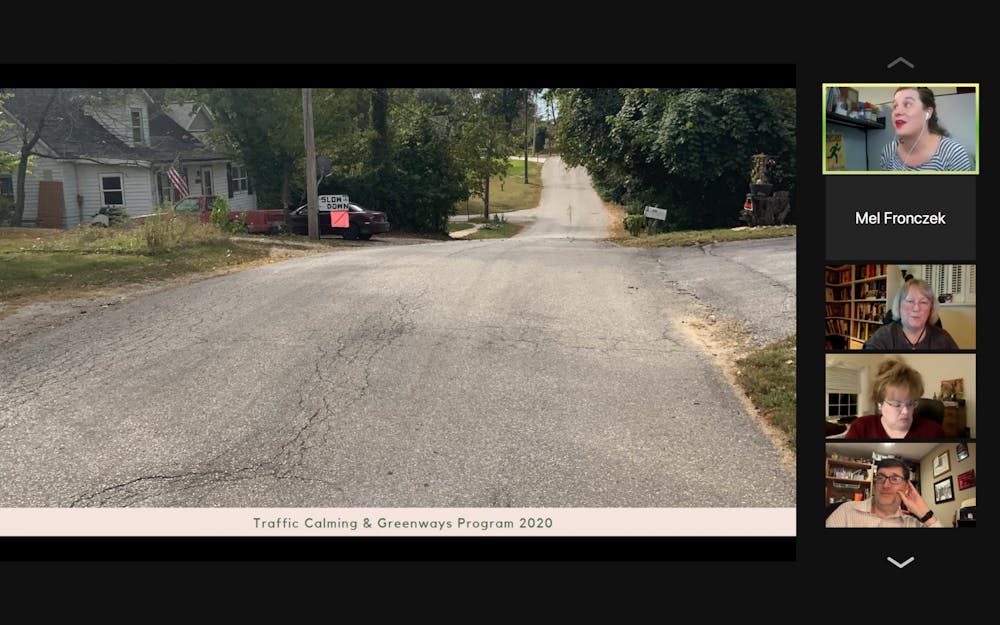There will be a new process for getting traffic calming devices into neighborhoods, thanks to a unanimous vote by the Bloomington City Council on Wednesday night.
The Planning and Transportation Department’s reinvented program to install traffic calming devices — such as speed cushions, pavement markings and signage — is twofold. First, it makes the process for residents to request the devices in their neighborhoods more straightforward. Second, it establishes a process for city staff to request traffic calming devices.
Mallory Rickbeil, the city’s bicycle and pedestrian coordinator, said she’s spoken to about 100 residents who are concerned about speed noncompliance in their neighborhoods. But she said the old resident-led process required too much organization on residents’ part.
“They feel like this is a risk for them, it’s a risk for their children,” she said. “Walking them through that process of everything that needs to happen, you can kind of start to feel the people begin to be demoralized and feel like it is really onerous.”
Under the new resident-led process, the city’s Bicycle and Pedestrian Safety Commission will analyze crash data, speed data, demographics and more, Rickbeil said. The commission will release a report every November that will show which neighborhoods are most vulnerable, and residents can make requests for a traffic calming project in their neighborhoods. Then, the Planning and Transportation Department will decide which projects to pursue.
Council members discussed how many resident signatures were needed for a resident’s request to be considered by the city. Rickbeil’s proposal required the lesser of 51% or 24 signatures, but council member Kate Rosenbarger suggested it be the lesser of 30% or 24 signatures to decrease the barriers to apply for a traffic calming project.
“I think by lowering that percentage, you just kind of level the playing field for smaller streets and you don’t penalize smaller projects,” Rosenbarger said.
Some council members said they weren’t sure if the number of required signatures should be that low.
Bloomington resident Katie Yoder said she was excited about Rosenbarger’s suggestion because it makes the process more approachable, and it could save residents from having to go door-to-door during a pandemic.
Yoder said she lives in a neighborhood with wide streets, built to accommodate big cars of the 1970s.
“Even with the sidewalks, it’s so scary to think about our kids becoming the age where they’re old enough to bike in the neighborhood,” she said. “It’s not a stranger danger. I'm afraid they're going to get killed by a car going 40 miles per hour.”
In a collision between a car going 20 miles per hour and a pedestrian, the pedestrian fatality rate is about 10%, according to the U.S. Department of Transportation. However, with a car going 40 miles per hour, the pedestrian fatality rate rises to 80%. Speeding is involved in 37% of fatal crashes on local streets, according to the National Highway and Traffic Safety Administration.
Bloomington resident Greg Alexander supported the program and the lower percentage of required signatures.
“Getting people to obey the speed limit is the goal of this program,” he said. “Safety is not something we need to carefully avoid pushing on the unwilling. Safety is something we owe to every single member of the city.”
Alexander said everyone should be concerned that multiple pedestrians have been struck and died in recent years.
The council voted 8-0-1 in favor of a 30% minimum of resident signatures required to apply for a traffic calming project. Council member Jim Sims abstained.
Rickbeil also said slower streets are more equitable streets. The pedestrian fatality rate for Latino and Black Americans is more than 60% and 75% higher, respectively, than for white residents, she said. In counties where more than 20% of households have income below the federal poverty line, the pedestrian fatality rate is more than 80% higher than the national average.






